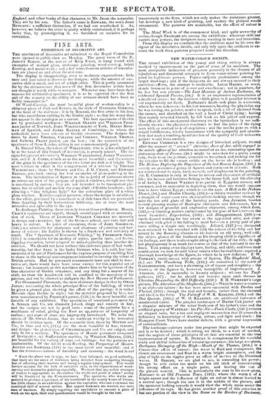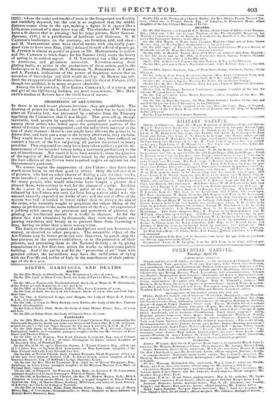NEW WATER-COLOUR SOCIETY.
THE annual exhibition of this young and rising society is always marked by improvement on the part of some of its members. The most acceptable indication of progress generally is the absence of all injudicious and distasteful attempts to force water-colour painting be- yond its legitimate powers. Figure.subjects predominate among the larger drawings ; and if the designers do not always succeed in their ambitious efforts, the attempt is creditable. Louts HAGHE, as usual, stands foremost in point of Dower and excellence ; not in numbers, for he has hut one picture—The Last Moments of Andrea Zurbaran, the celebrated Spanish Painter, (66.) It is an impressive representation of a deathbed scene ; but the iucident which gives to it peculiar interest is not expressively set forth. Zurbaran's death took place in a convent, where he was unknown : in his last moments, hearing the physician say he was raviug, the painter, unah'e to speak, took a bit of charcoal from the censer, and sketched on the wall a head of Christ dying : having thus mutely revealed himself, he fell back on his pillow and expired. The effect of this unexpected discovery on the bystanders is not suffi- ciently shown : the physician continues to feel the pulse of the dying man with an averted look of scepticism ; and the monks gaze on with a stupid indifference, wholly inconsistent with the sympathy and adtuira- lion that such a touching manifestation of the quality of their unkuown patient would have excited. EDWARD CORBOULD lir:S two designs of historical suljects, treated after the manner of " annual " pictures: Joan of Arc, while engaged in the servile offices of her situation as menial at an inn, ruminating upon the distressing state of France, (26,) might be mistaken for a pretty young lady, fresh from the psrlour, mounted on horseback and looking out for the cavalier to fill the vacant saddle on the horse she is leading ; and The Britons Deploring the Departure of the last Roman Legion, (101,) is merely an academical group of figures and eostuates in attitude. Both are conventional in style, hard, smooth, and diaphanous in the painting. Mr. E. CORBOULD is only at home in scenes and characters of artificial life ; his heroes and heroines belong to the fancy-hall, and his chivalry is of Astley's. HENRY WARREN iS so partial to Egyptian scenery and costumes, and so successful in depicting them, that one would suppose him to have visited Egypt which is not the case. A Halt in the Nubian Desert, (84,) and Muslim Charity, (292,)—a thirsty traveller revived by a draught of water—are two characteristic-looking scenes; though we miss the hot arid glare of the burning sands. Jos. J ENKINS, besides. several pleasing studies of Boulogne shrimpers and fishwomen, has a few designs of graceful and expressive character, among which love, (123,)—a blushieg maiden embarrassed by the gaze of her lover—is the most beautiful ; Expectation, (106); and Disappointment, (299.)—a rustic damsel waiting for her swain at the appointed stile, and over- whelmed with grief at his failing to meet her—are a pretty pair of pic- tures telling a simple tale touchingly. Misted, (227,)—a dissipated titan returned to his wretched wife with the tokens of his folly and her misery in the flaunting ribands on his hat—is an old story, well told; the turtive glance of the husband at his sleeping child is significant of his feelings, and there is silent upbraiding in the look of the wife; thaugh her physiognomy is as much too coarse as that of the husband is too re- fined. This young artist displays taste, feeling, and skill ; and from their combiaation we look for still better results when he shall have acquired a thorough knowledge of the figure, in which he is now deficient. F. W. TOPHAIeS rustic scenes with groups of figures, The Shepherds' Meal, (6.) and The IYandering Tribe, (232,) are conceived in the spirit of GAINSBOROUGH, and have a charming air of repose and simplicity : the drawing of the figures is, however, susceptible of improvement. J. ABSOLON, also, is successful in homely subjects ; witness his Tar/- gatherers, (87) ; but he should not venture upon such themes 28 Christian Descending the Hill Dfficulty. (259.) E H. WEHNERT'S large picture, The Adoration oft/me Shepherds, (244,)—WEST in water-colours— is an elaborate failure : he has been more successful with Perdita and Florizel, (316) ; though the real and homely, rather than the elevated and ideal, is his forte. The Falstaff of %V. K. KEELING, (308,) and the Don Quixote. (165,) of W. ii. KEARNEY, are additional instances of misdirected talent. The peopled landscapes of HAMM COX junior are a singular mixture of the sober freshness of his father's tone and the artificial gayety of Warman : his Pic-Nic—Powis Castle, (146.) evinces an elegant taste, but a lax and negligent mannerism that ill conceals a deficiency in knowledge of drawing, colour, and light and shade : his Hampton Court Views have similar defects, with a general impression of verisimilitude.
The landscape-painters make less progress than might be expected and is to be desired ; which is owing, we think, to a want of method, and the neglect of those principles of art that are essential to the true representation of nature. E. DUNCAN is conspicuous for his watchful study and skilful delineation of natural appearances: his large sea-piece, Barleymen Shrimping off the 'Pig/a—Mouth of the Thames, (264.) is a Claude-like effect of sunset: the water is fluid and transparent, the clouds are evanescent and float in a warm bright atmosphere, and the play of light on the ripples gives an effect of motion to the illumined waves. H. BRIGHT, we are glad to see, is extending his power; though he still relies too much on his old trick of concentrating his strong effect on a single point, and leaving the rest of the picture neutral. This is particularly the case in his snow-piece, Entrance to an Old Prussian Town, (195); where the warm h of a bright sunset and the influence of light on colour is almost limited to a central spot ; though the sun is in the middle of the picture, and the spectator looking towards it would view the whole scene under the influence of its rays. He has given another proof of this attentiou to but one portion of the view in the Scene on the Borders of Dartmoor, (222); where the rocks and trunks of trees in the foreground are forcibly and truthfully depicted, but the rest is so neglected that the middle distance comes close to the eye, making a figure in it appear like a Lilliputian instead of a man some way off. The sketches of W. OLIVER have a freshness that is pleasing ; but his large picture, Saint Sauveur, Pyrenees, (137,) is a petrifaction of hardness and littleness. G. B. Ceramotes landscapes, on the contrary, are formless, arid, and adust and H. MAPLESTONE must have viewed nature with physically-jaun- diced eyes to have seen Eton, (196.) deluged in such a flood of gamboge. H. JUTSUM is almost as partial to green as Mr. MAPLESTONE to yellow and Mr. Camelot to brick-dust; for his Summer (105) wears the livery of spring in its coldest aspect. J. M. YOUNGMAN has a like tendency to greenness, and glassiness moreover. Notwithstanding these glaring faults, we notice in the productions of these artists, and in the landscapes of G. DODGSON, H. P. RIVIERE, W. ROBERTSON. J. FAHEY, and A. PENLEY, indications of the power of depicting nature that an accession of knowledge and skill would develop. G. HowsE has sub- dued the exaggerations of his mannerism ; and his view at Cologne, (53,) though too artificial, is in many respects admirable. Among the few portraits, Miss Louisa. Coartaux's, of a young man and girl of the Ojibbeway Indians, are most conspicuous. Mrs. MAR- GETT's studies of flowers have the vivid hues of nature.



























 Previous page
Previous page